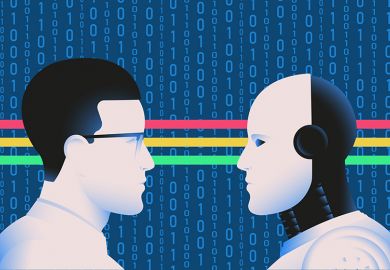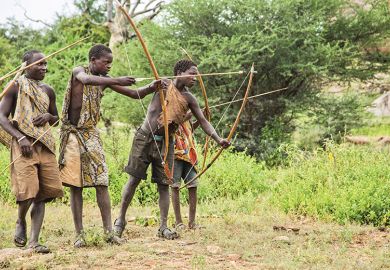Ever since Europeans first encountered the Americas, the Amazon has been a rich source of metaphor, of constructed worlds, informed reflexively by imagination and reality. Amazonia has alternately excited western fears, greed and sorrow. It has been a "green hell", a "garden of Eden", an El Dorado and the ailing "lungs of the world". Its indigenous peoples too have undergone transformations from semi-human creatures to cannibals, "noble savages" and ecopoliticians.
Partly due to these shifting views, the Amazon has hitherto attracted more anthropologists than archaeologists. The potential rewards of studying living people and recording the rich and intricate details of their lives outweighed the difficult business of excavating in the tropics. In addition, as it was generally agreed that Indians were "living fossils", archaeology was an expensive way of verifying what we already knew. Present-day Amazonian hunter-gatherer tribes were regarded as having become perfectly adapted to jungle living over thousands of years. This view is now acknowledged as yet another deceit and is increasingly untenable.
In Amazonian Indians, Anna Roosevelt has produced a cross-disciplinary volume that offers a new agenda for the study of indigenous Amazonian peoples, past and present. A major theme is the rejection of the view which characterised the tropical rainforest as a uniformly impoverished "counterfeit paradise". By exploring the archaeology, ethnology and cultural ecology of the region we see instead a mosaic of environments supporting a diversity of social formations and adaptations over the past 11,000 years.
One of the myths laid bare is what Roosevelt calls ethnology's consensus view that current Indian societies represent the optimum adaptation to such environments. The truth is more complex. Down to around 2,000 years ago Amerindians lived in much the same way as they do today. But from that time until European contact in the 16th century many Amazonian cultures developed from small widely scattered villages to larger more complex polities producing far denser occupation sites. These chiefly societies practised long-distance trade, constructed monumental earthworks, and adopted maize rather than manioc as a staple food.
For example, on Marajo Island, at the mouth of the Amazon, clusters of occupational debris cover areas of between 10 to 20 sq km - a figure which is comparable to say the great pre-Aztec metropolis of Teotihuac n in Mexico. The extent of other Amazonian sites with habitations, cemeteries and earthworks also parallel more famous Maya or Inca settlements though admittedly with no stone architecture.
The point is forcefully made by many contributors that it was this tremendous density of occupation and social complexity that was destroyed and then forgotten by Europeans. Present-day tribes are often the ethnically mixed survivors of conquest, disease and marginalisation. Even such typical hunter-gatherers as the Brazilian Bororo are shown to have been pottery-using maize horticulturalists up until the 19th century. Such evidence has wide implications - not least in terms of health. Whereas in prehistory native Amazonians averaged 172 cm in height, today their descendants manage only 160 cm.
Roosevelt has chosen her contributors with care to elucidate the interconnections between archaeology, ethnohistory, ethnology, human biology and ecology. The integrative approach adopted here and the many excellent contributions represent a significant step in building a new framework for understanding the Amazon and its indigenous peoples.
Against this revisionist background, Getting to know Waiwai by Alan Tormaid Campbell looks like just another social anthropologist's "insider" view of an Amazonian indian society under threat, in this case, the 150 or so surviving Wayap! of northeast Brazil, and their chief, Waiwai. This impression is quickly dispelled. Campbell has written a richly detailed, and intriguing book. Moving deftly back and forth between the worlds of the Wayap!, western civilisation and academic anthropology - he tells a uniquely informative story in entertaining style.
By learning the Wayap! language, Campbell tried to comprehend the endlessly subtle configurations of meaning and imagination that invest the rainforest world with mythological significance.
Yet, even thus equipped, he questions whether we can ever really understand the distinctively non-western architecture of indigenous thought and practice. It is with the "ethnographic present" that he is concerned. The only real time-depth involved is the future, when unborn Wayap! generations might read his account of their ancestors.
The Wayap! hover on the brink of extinction. What we should admire is not any clinging to a timeless past but rather their ability to adapt to and survive centuries of relentless European pressure. This is a postmodern adventure, unashamedly personal, erudite, and sharply perceptive.
Nicholas J. Saunders is visiting research fellow in archaeology, University of Southampton.
Amazonian Indians from Prehistory to the Present: Anthropological Perspectives
Editor - Anna Roosevelt
ISBN - 0 8165 1436 4
Publisher - University of Arizona Press
Price - $60.00
Pages - 420
Register to continue
Why register?
- Registration is free and only takes a moment
- Once registered, you can read 3 articles a month
- Sign up for our newsletter
Subscribe
Or subscribe for unlimited access to:
- Unlimited access to news, views, insights & reviews
- Digital editions
- Digital access to THE’s university and college rankings analysis
Already registered or a current subscriber?



